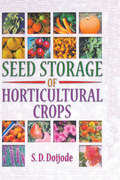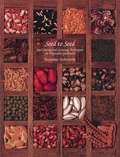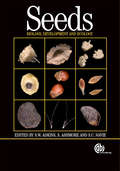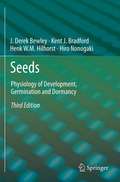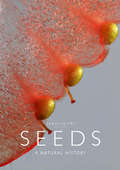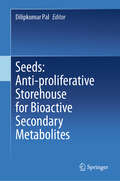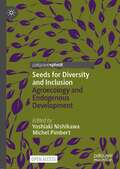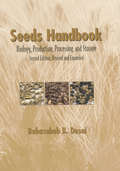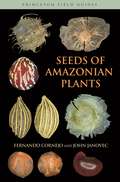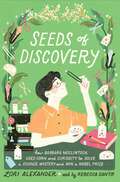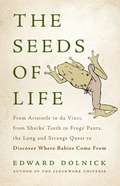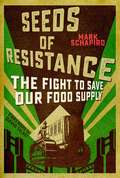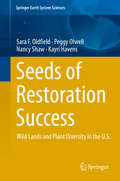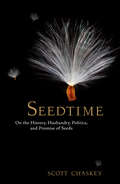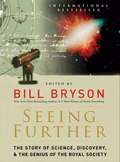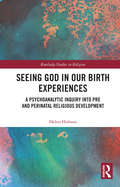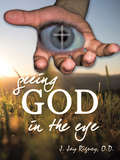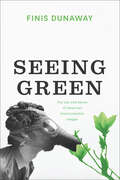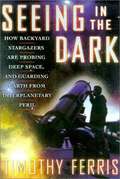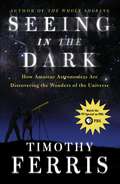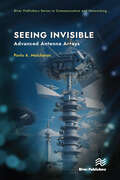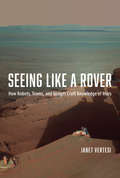- Table View
- List View
Seed Storage of Horticultural Crops
by S.d. DoijodeMaintain viability with these techniques for proper seed storage!Healthy, viable seeds are the foundation for sustainable crop production, while poorly kept seeds can result in low germination and crop loss. Seed Storage of Horticultural Crops suggests appropriate strategies to help farmers and breeders store seeds of all kinds.
Seed To Seed: Seed Saving And Growing Techniques For The Vegetable Gardener
by Suzanne Ashworth Kent WhealySeed to Seed is a complete seed-saving guide that describes specific techniques for saving the seeds of 160 different vegetables. This book contains detailed information about each vegetable, including its botanical classification, flower structure and means of pollination, required population size, isolation distance, techniques for caging or hand-pollination, and also the proper methods for harvesting, drying, cleaning, and storing the seeds. Seed to Seed is widely acknowledged as the best guide available for home gardeners to learn effective ways to produce and store seeds on a small scale. The author has grown seed crops of every vegetable featured in the book, and has thoroughly researched and tested all of the techniques she recommends for the home garden. This newly updated and greatly expanded Second Edition includes additional information about how to start each vegetable from seed, which has turned the book into a complete growing guide. Local knowledge about seed starting techniques for each vegetable has been shared by expert gardeners from seven regions of the United States-Northeast, Mid-Atlantic, Southeast/Gulf Coast, Midwest, Southwest, Central West Coast, and Northwest.
Seeds: Biology, Development and Ecology
by Steve W. AdkinsProviding comprehensive coverage of the latest seed science research including germination, dormancy, development, and desiccation tolerance, this book also details the most advanced methods and practices in seed biology, ecology and technology.
Seeds
by Kent Bradford J. Derek Bewley Henk Hilhorst Hiroyuki NonogakiThis updated and much revised third edition of Seeds: Physiology of Development, Germination and Dormancy provides a thorough overview of seed biology and incorporates much of the progress that has been made during the past fifteen years. With an emphasis on placing information in the context of the seed, this new edition includes recent advances in the areas of molecular biology of development and germination, as well as fresh insights into dormancy, ecophysiology, desiccation tolerance, and longevity. Authored by preeminent authorities in the field, this book is an invaluable resource for researchers, teachers, and students interested in the diverse aspects of seed biology.
Seeds: A Natural History
by Carolyn FryFrom the magnificence of a towering redwood to the simple elegance of a tiny dandelion, seed-bearing plants abound on planet Earth. The sheer diversity of plants thriving today is largely thanks to the evolution of the seed, as this made plants resilient to environmental changes by enabling them to await optimum conditions for growth before springing to life. In a time of declining biodiversity, studying seeds is now helping scientists preserve this plant diversity for future generations. With Seeds, Carolyn Fry offers a celebration of these vital but unassuming packages of life. She begins with a sweeping tour through human history, designed to help us understand why we should appreciate and respect these floral parcels. Wheat, corn, and rice, she reminds us, supply the foundations of meals eaten by people around the world. Countless medicines, oils, clothing materials, and building supplies are available only because of the versatility and variety of seed-bearing plants. Fry then provides a comprehensive history of the evolution of seeds, explaining the myriad ways that they have adapted, survived, and thrived across the globe. Delving deeper into the science of seeds, she reveals the fascinating processes of dormancy, reproduction, germination, and dispersal, and showcases the estimable work conservationists are doing today to gather and bank seeds in order to prevent species from going extinct. Enriched by a stunning array of full-color images, Seeds offers a comprehensive exploration of some of the most enduring and essential players in the natural world.
Seeds: Anti-proliferative Storehouse for Bioactive Secondary Metabolites
by Dilipkumar PalThis book presents extensive and up-to-date information on the anti-proliferative properties of various plant seeds for their application in pharmaceutical industry and medicinal research. This information is imperative for understanding and developing high quality products from the seeds.The book provides insights about anticancer and antitumour activities present in seeds. Different chapters cover the traditional knowledge as well as recent innovations in various seeds, such as prune, pumpkin, grape fruit, sesame, sunflower, bitter gourd, papaya, mango, apple, black plum, cumin, water melon, musk melon, cotton, carambola, pear, cardamon, moringa, wallich, Chinese cabbage, pistachio, etc. and their bioactivities for the applications in cancer and malignancy proliferation. The book introduces the readers to seed as a bioactive compound, and delineates the various health effects. It further explains the relation between the different metabolites and their effect on cell proliferation. Finally the book goes on to explain different seeds and their specific anti-cancer properties. This book is useful for students and researchers of pharmacology, botany and cancer research. It also caters to industry experts in pharmaceutical sciences.
Seeds for Diversity and Inclusion: Agroecology and Endogenous Development
by Yoshiaki Nishikawa Michel PimbertThis open access book will contribute to a more nuanced debate around seed system resilience that goes beyond the dominant dichotomous conceptualization of seed governance often characterized as traditional vs modern, subsistence vs commercial, or local vs global. While reflecting on the expanding oligopoly in the current seed system, the authors argue that such classifications limit our ability to critically reflect on and acknowledge the diverse approaches through which seed governance is practiced around the world, at various scales, creating a mosaic of dynamic complementarities and autonomies. The authors also highlight the importance of this much needed dialogue through case studies of seed governance approaches and practices found in and around Japan.
Seeds Handbook: Processing And Storage
by Babasaheb B. DesaiRevised and expanded throughout, this latest edition of the bestselling Seeds Handbook: Biology, Production, Processing, and Storage includes valuable information on all areas of seed biology, production, and processing. The author, one of the most respected and prolific scientists in the field, identifies current developments in seed testing and c
Seeds of Amazonian Plants (Princeton Field Guides #66)
by Fernando Cornejo John JanovecSeeds of Amazonian Plants is the first field guide to treat the extraordinary diversity of seeds and diaspores of plants commonly encountered in the Amazon and other lowland moist forests of the American tropics. This stunningly illustrated guide features an easy-to-use whole-plant approach to seed identification that provides detailed descriptions not only of the seeds but also of the habit, trunk, bark, leaves, infructescence, and fruit of Amazonian plants, as well as information about the known uses and distribution of each genus. Presenting these descriptions together with 750 full-color photos and a unique identification key, this premier field guide enables users to identify seeds of 544 genera and 131 families of plants. The most comprehensive field guide to Amazonian seeds Features 750 full-color photos that make identification easy Covers 544 genera and 131 families of Amazonian plants Describes seeds, habit, trunk, bark, leaves, infructescence, and fruit Includes unique seed identification key Compact, portable, and beautifully illustrated--the ideal field guide
Seeds of Discovery: How Barbara McClintock Used Corn and Curiosity to Solve a Science Mystery and Win a Nobel Prize
by Lori AlexanderThe quirky and singular Nobel Prize winner Barbara McClintock, a founder of modern genetics who did things her own way, is honored in this lively young STEM biography by Sibert Honor winner Lori Alexander. Celebrating the power of curiosity and the rewards of tenacity, this engaging and highly illustrated biography introduces young readers to the field of genetics. As a rare female botanist in early twentieth-century America, Barbara McClintock never let other people’s notions of what was proper slow her down. When she faced doubting colleagues and unsupportive institutions, she drove across the United States, climbed through windows, and even slept in her laboratory to conduct her research. In so doing, she helped pave the way for future scientific discoveries that can cure diseases and save lives—and won a Nobel Prize in the process!Back matter includes a timeline, glossary, source notes, and further reading.
The Seeds of Life: From Aristotle to da Vinci, from Sharks' Teeth to Frogs' Pants, the Long and Strange Quest to Discover Where Babies Come From
by Edward DolnickWhy cracking the code of human conception took centuries of wild theories, misogynist blunders, and ludicrous mistakes Throughout most of human history, babies were surprises. People knew the basics: men and women had sex, and sometimes babies followed. But beyond that the origins of life were a colossal mystery. The Seeds of Life is the remarkable and rollicking story of how a series of blundering geniuses and brilliant amateurs struggled for two centuries to discover where, exactly, babies come from. Taking a page from investigative thrillers, acclaimed science writer Edward Dolnick looks to these early scientists as if they were detectives hot on the trail of a bedeviling and urgent mystery. These strange searchers included an Italian surgeon using shark teeth to prove that female reproductive organs were not 'failed' male genitalia, and a Catholic priest who designed ingenious miniature pants to prove that frogs required semen to fertilize their eggs.A witty and rousing history of science, The Seeds of Life presents our greatest scientists struggling-against their perceptions, their religious beliefs, and their deep-seated prejudices-to uncover how and where we come from.
Seeds of Resistance: The Fight to Save Our Food Supply
by David Talbot Mark SchapiroSun. Soil. Water. Seed. These are the primordial ingredients for the most essential activity of all on earth: growing food. All of these elements are being changed dramatically under the pressures of corporate consolidation of the food chain, which has been accelerating just as climate change is profoundly altering the conditions for growing food. In the midst of this global crisis, the fate of our food has slipped into a handful of the world’s largest companies. Food Chained will bring home what this corporate stranglehold is doing to our daily diet, from the explosion of genetically modified foods to the rapid disappearance of plant varieties to the elimination of independent farmers who have long been the bedrock of our food supply.Food Chained will touch many nerves for readers, including concerns about climate change, chronic drought in essential farm states like California, the persistence of the junk food culture, the proliferation of GMOs, and the alarming domination of the seed market and our very life cycle by global giants like Monsanto.But not all is bleak when it comes to the future of our food supply. Food Chained will also present hopeful stories about farmers, consumer groups, and government agencies around the world that are resisting the tightening corporate squeeze on our food chain.
Seeds of Restoration Success: Wild Lands and Plant Diversity in the U.S. (Springer Earth System Sciences)
by Nancy Shaw Kayri Havens Sara F. Oldfield Peggy OlwellThis book provides a general overview of the natural landscapes and vegetation types of the U.S., the key plant species that help define them, the pressures faced by natural ecosystems and the imperative for conservation and restoration. It addresses the policies that have been introduced to manage healthy ecosystems and the practical progress that is being made in restoration. A particular focus is on the production of diverse native plant materials currently required by the National Seed Strategy. Case studies demonstrate how native plant materials are essential to support the conservation of healthy ecosystems with their biodiversity and functions as well as supporting a productive and sustainable agricultural sector and healthy ecosystems for all. The authors are closely connected with major national and international networks of botanic gardens, ecologists and conservation scientists at Board level and through other professional links. Condensing a wide range of current information into a concise format, this book fills a need by experts and informed amateurs interested in the natural environment, including gardeners, botanic garden and protected area visitors, government agencies, the private sector native seed industry, and NGOs.
Seedtime: On the History, Husbandry, Politics and Promise of Seeds
by Scott ChaskeyScott Chaskey—working farmer, poet, and spiritual father of the community farming movement—considers "the web of biodiversity and resilience at the heart of our cultural inheritance" by masterfully weaving history, politics, botany, literature, mythology, and memoir into a beautiful and instructive book.It's hard to think of a subject more fundamental to the sustenance of the human race than seeds. Having coevolved with the Earth's plants, insects, and animals, seeds are entwined with the core myths of ancient cultures and the development of human consciousness. Their story remains vitally important today, as the corporations that manufacture GMOs threaten our food security and the future of seed-cultivated agriculture.The stakes, for those concerned with preserving biodiversity and ecological integrity, are high. Balancing a wide view of politics and history, Chaskey alights from life on the farm he has cultivated for 25 years to conjure Gregor Mendel's breeding experiments that yielded our modern understanding of genetics; he also introduces us to several "bioneers," such as the geobotanist Nikolay Vavilov and agriculturalist Cary Fowler, who are preserving global biodiversity through seeds. Integrating scholarship with accessible storytelling, Seedtime is a celebration as well as a call to action urging us to renew our role as citizens of nature, in ecologist Aldo Leopold's phrase, not as conquerors of it.
Seeing Eye to Eye: From Brown Irises to Blue (Fountas & Pinnell Classroom, Guided Reading Grade 6)
by Carmen MoraisA Range of Colors Dark chocolate, forest green, sky blue, greenish-brown hazel … human eyes come in many possible shades. And it all started thousands of years ago, with one baby born with very strange eyes. NIMAC-sourced textbook
Seeing Further
by Bill BrysonThis revised e-book features all photographs, designed in beautiful full-color. Edited and introduced by Bill Bryson, with original contributions from "a glittering array of scientific writing talent" (Sunday Observer) including Richard Dawkins, Margaret Atwood, Richard Holmes, Martin Rees, Richard Fortey, Steve Jones, James Gleick, and Neal Stephenson, among others, this incomparable book tells the spectacular story of science and the international Royal Society, from 1660 to the present. Seeing Further is also gorgeously illustrated with photographs, documents, and treasures from the Society's exclusive archives. On a damp weeknight in November three hundred and fifty years ago, a dozen men gathered in London. After hearing an obscure twenty-eight-year-old named Christopher Wren lecture on the wonders of astronomy, his rapt audience was moved to create a society to promote the accumulation of useful-and fascinating-knowledge. At that, the Royal Society was born, and with it, modern science. Since then, the Royal Society has pioneered global scientific exploration and discovery. Its members have split the atom, discovered the double helix and the electron, and given us the computer and the World Wide Web. Isaac Newton, Charles Darwin, Albert Einstein, Robert Hooke, Robert Boyle, Joseph Banks, Humphry Davy, John Locke, Alexander Fleming, Stephen Hawking-all have been fellows. Bill Bryson's favorite fellow is the Reverend Thomas Bayes, a brilliant mathematician who devised Bayes' theorem. Its complexity meant that it had little practical use in Bayes' own lifetime, but today his theorem is used for weather forecasting, astrophysics, and even stock-market analysis. A milestone in mathematical history, it exists only because the Royal Society decided to preserve it-just in case. Truly global in its outlook, the Royal Society now is credited with creating modern science. Seeing Further is an unprecedented celebration of its history and the power of ideas, bringing together the very best of science writing.
Seeing God in Our Birth Experiences: A Psychoanalytic Inquiry into Pre and Perinatal Religious Development. (Routledge Studies in Religion)
by Helen HolmesThere has been a recent surge in the examination of the evolutionary roots of religious belief, all trying to identify where the human desire to seek the supernatural and the divine comes from. This book adds a new and innovative perspective to this line of thought by being the first to link prenatal and perinatal experiences to the origins of these unconscious underpinnings of our shared images of God. The book poses a ground-breaking paradigm by thinking about our earliest images of God, whether theist or atheist, within a psychoanalytic framework, comparing and contrasting the thought of Freud and Rizzuto. It looks at the issue of images of God from a diversity of psychological perspectives including, attachment theory, developmental theory and bio-psychosocial perspectives. This analysis leads to the conclusion that in parallel to postnatal findings, uterine and birth experiences can predispose individuals to form God representations later in life, through underpinning affective and environmental factors. This is a bold study of the development of one of humanity’s most fundamental aspects. As such, it will be of great interest to scholars of the psychology of religion, psychology, psychoanalysis, religious studies and early infant development.
Seeing God in the Eye: The Eye Proves Interdependent Evidence of Creation
by J. Jay Rigney, O.D.God has proven Himself so effectively to everyone that HE says there is NO EXCUSE in not believing in Him. (Romans 1: 19 & 20) Would God say that, and then not provide the proof that He exists ? This book introduces a new theory; INTERDEPENDENT EVIDENCE OF CREATION, and PROVES that theory. This book provides the PROOF you may be looking for of God’s existence. Dr. Jan Jay Rigney graduated from Northeastern State University in Tahlequah, Oklahoma in 1984. At the time of the writing of this book, he will have been in private practice Optometry for thirty-one years. While practicing Optometry, he has had the opportunity to daily, for over 35 years, observe the design, function, and intricate interworkings of the human eye.
Seeing Green: The Use and Abuse of American Environmental Images
by Finis DunawayThis “smart, highly readable book” examines how the iconography of environmentalism has help shape—and limit—popular discourse (American Studies).American environmentalism is defined by its icons: from the “Crying Indian” who shed a tear over litter to Al Gore’s documentary An Inconvenient Truth. These kinds of images helped make environmental consciousness central to American culture. And yet these same images obscured critical environmental truths. Finis Dunaway examines this dual role in Seeing Green.Considering a wide array of images—from print magazines and television news to political posters and even cartoons—Dunaway shows how popular environmentalism has been entwined with mass media spectacles of crisis. He focuses on key moments in which media images provoked environmental anxiety while prescribing limited forms of action. Moreover, he shows how the media blamed individual consumers for environmental degradation and thus deflected attention from corporate and government responsibility.Ultimately, Dunaway argues, iconic images have impeded efforts to realize—or even imagine—sustainable visions of the future. Generously illustrated, this innovative book examines both the history of environmentalism and the power of the media to shape our politics.
Seeing in the Dark: How Backyard Stargazers Are Probing Deep Space and Guarding Earth from Interplanetary Peril
by Timothy Ferris"Seeing in the Dark" is a poetic love letter to the skies and a stirring report on the revolution now sweeping amateur astronomy, in which backyard stargazers linked globally by the Internet are exploring deep space and making discoveries worthy of professionals. Timothy Ferris invites us all to become stargazers, recounting his lifelong experiences as an enthralled stargazer, and capturing the exquisite experience when ancient starlight strikes the eye and incites the mind.--From book jacket
Seeing in the Dark: How Amateur Astronomers Are Discovering the Wonder
by Timothy FerrisIn Seeing in the Dark, a poetic love letter to science and to the skies, Timothy Ferris invites us all to become stargazers. He recounts his own experiences as an enthralled lifelong amateur astronomer and reports from around the globe -- from England and Italy to the Florida Keys and the Chilean Andes -- on the revolution that's putting millions in touch with the night sky. In addition, Ferris offers an authoritative and engaging report on what's out there to be seen -- what Saturn, the Ring nebula, the Silver Coin galaxy, and the Virgo supercluster really are and how to find them. The appendix includes star charts, observing lists, and a guide on how to get involved in astronomy.Ferris takes us inside a major revolution sweeping astronomy, as lone amateur astronomers, in global networks linked by the Internet, make important discoveries that are the envy of the professionals. His ability to describe the wonders of the universe is simply magical, and his enthusiasm for his subject is irresistible.
Seeing in the Dark
by Timothy FerrisIn Seeing in the Dark, a poetic love letter to science and to the skies, Timothy Ferris invites us all to become stargazers. He recounts his own experiences as an enthralled lifelong amateur astronomer and reports from around the globe -- from England and Italy to the Florida Keys and the Chilean Andes -- on the revolution that's putting millions in touch with the night sky. In addition, Ferris offers an authoritative and engaging report on what's out there to be seen -- what Saturn, the Ring nebula, the Silver Coin galaxy, and the Virgo supercluster really are and how to find them. The appendix includes star charts, observing lists, and a guide on how to get involved in astronomy.Ferris takes us inside a major revolution sweeping astronomy, as lone amateur astronomers, in global networks linked by the Internet, make important discoveries that are the envy of the professionals. His ability to describe the wonders of the universe is simply magical, and his enthusiasm for his subject is irresistible.
Seeing Invisible: Advanced Antenna Arrays (River Publishers Series in Communications and Networking)
by Pavlo A. MolchanovThis book provides a simple explanation of existing antenna arrays, their advances and limitations. It will lead you to nature-inspired next generation antenna array design and their advances.Why antenna arrays? Because antennas or antenna arrays are the primary element in any sensory system or circuit. Any artificial intellect, computer, vision, communication, or detection system cannot work properly without a properly designed sensor system or antenna array. They include not only technical areas like communication, navigation and radars, but also health care, medical imaging and even amateur metal detectors and RC vehicle design.Taking into account today’s military and geo-political threats, the book will also help you understand the functional needs of the new generation of antenna arrays for various radar and anti-missile systems to meet those threats. It also covers the evolution of antennas and antenna array design and gives insight into the fundamental function and advances of nature inspired new generation, fly eye antenna arrays and their applications.This book is intended for a wide area of readers and does not require special education, but it is a valuable resource for engineers and technicians who are involved in the design and development of all space communication and navigation systems, and drones, and hypersonic missiles detection systems, with special emphasis on interference immunity and protection. It also can be used as a textbook in advanced radar technology coursework and seminars.
Seeing Like a Rover: How Robots, Teams, and Images Craft Knowledge of Mars
by Janet VertesiIn the years since the Mars Exploration Rover Spirit and Opportunity first began transmitting images from the surface of Mars, we have become familiar with the harsh, rocky, rusty-red Martian landscape. But those images are much less straightforward than they may seem to a layperson: each one is the result of a complicated set of decisions and processes involving the large team behind the Rovers. With Seeing Like a Rover, Janet Vertesi takes us behind the scenes to reveal the work that goes into creating our knowledge of Mars. Every photograph that the Rovers take, she shows, must be processed, manipulated, and interpreted—and all that comes after team members negotiate with each other about what they should even be taking photographs of in the first place. Vertesi’s account of the inspiringly successful Rover project reveals science in action, a world where digital processing uncovers scientific truths, where images are used to craft consensus, and where team members develop an uncanny intimacy with the sensory apparatus of a robot that is millions of miles away. Ultimately, Vertesi shows, every image taken by the Mars Rovers is not merely a picture of Mars—it’s a portrait of the whole Rover team, as well.
